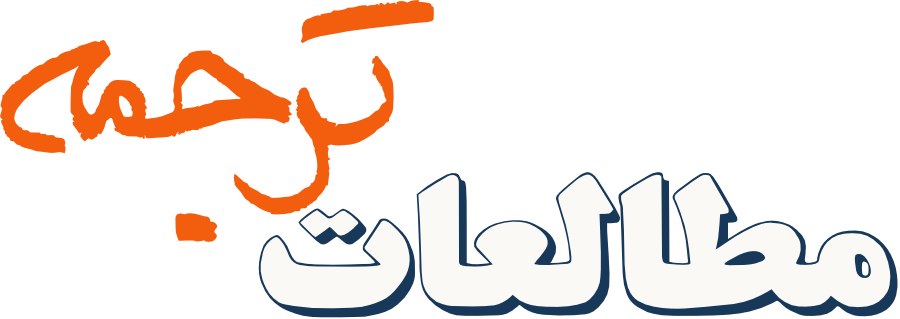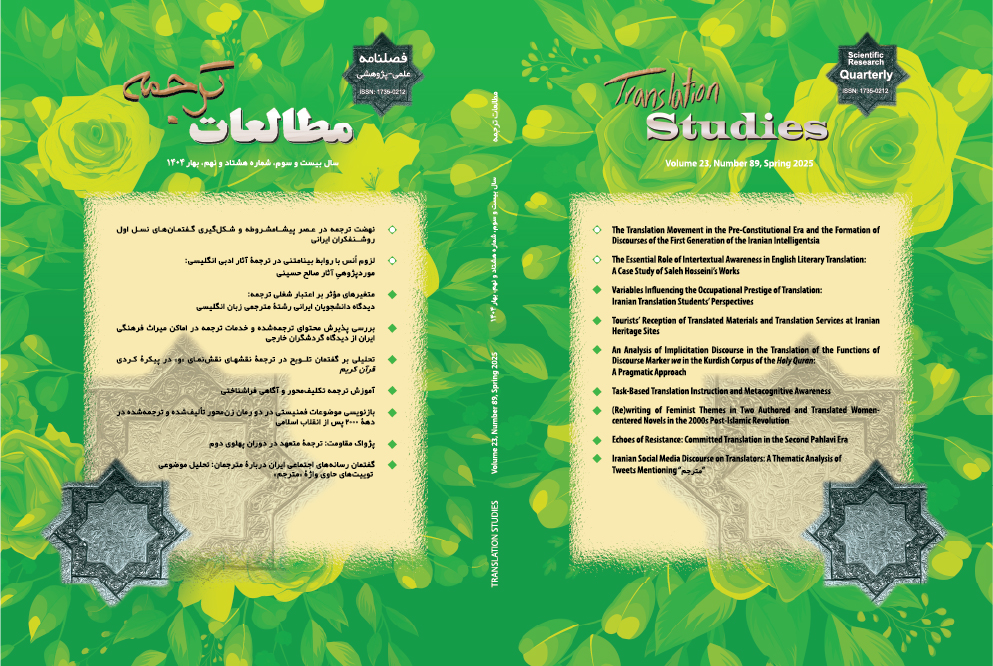تحلیلی بر گفتمان تلویح در ترجمۀ نقش¬های نقش¬نمای «و» در پیکرۀ کردی قرآن کریم:
رویکردی کاربردشناسی
چکیده
فرایند ترجمه متضمن درک، آفرینش، و مدیریت گفتمان بر اساس استفادة خلاقانه و حرفهای از نقشنماهاست و چالش اصلی مترجم آفرینش گفتمانی منطبق با متغیرهای کاربردشناسی مخاطب است (چسترمن، 2016؛ محمدی و همتی، 2023). از قلم انداختن و یا انعکاس غیرمستقیم نقشها و کارکردهای نقشنمای «و» به عنوان پرکاربردترین، کارآمدترین، و مبهمترین نقشنما فرایندی پیچیده، خلاق و گفتمان آفرین است. این مطالعۀ توصیفی و اکتشافی بر اساس نظریههای کاربردشناسی، معادلهای ترجمه (زوفری، 2016)، و الگوی تحلیل گفتمان تلویح (کلاودی و کارولی، 2005) به تجزیه وتحلیل ابعاد مختلف استفاده از راهبرد تلویح پرداخت. پیکرۀ این مطالعۀ توصیفی و اکتشافی شامل شش جزء قرآن کریم—که به صورت تصادفی انتخاب شدند—و ترجمۀ کردی سورانی (ابراهیمی، 1376) این شش جزء بود. نتیجۀ مطالعه نشان داد که مترجم قرآن کریم به زبان کردی نزدیک به دو سوم موارد (63 درصد) از راهبرد تلویح استفاده کرده بود. این رویکرد آفرینش گفتمان به کشف الگویی مثلثی انجامید که دارای اضلاع راهبرد دستوری، راهبرد لغوی، و راهبرد فرهنگی-کاربردشناسی است که شناخت ما را از جهانیهای ترجمه گسترش میدهد. کاربردهای گوناگون علمی، آموزشی و پژوهشی در حوزههای مختلف مطالعات ترجمه بررسی و مطالعه گردید. پژوهش های آینده می توانند ترجمۀ گفتمان نمای «و» را در زبانهای دیگر مطالعه و مقایسه کنند.
مراجع
The Holy Quran
Afrouz, M., & Mollanazar, H. (2018). A comparative study of the Holy Qur’ān’s English translations by Muhammad Ali and Shakir: Plagiarism or Revision? Iranian Journal of Translation Studies, 16(61), 51–68. Retrieved from https://journal.translationstudies.ir/ts/article/view/610/
Afrouz, M., & Mollanazar, H. (2017). Strategies opted for in translating twelve categories of Quranic terms. Iranian Journal of Translation Studies, 14(55). Retrieved from https://journal.translationstudies.ir/ts/article/view/410/
Aijmir, K. (2002). English Discourse Particles: Evidence from a corpus. Johan Benjamins.
Cartoni, L., Zuferrey, S. & Meyer, T. (2013). Annotating the meaning of discourse connectives by looking at their translation: The translation spotting. Dialogue and Discourse, 4(8), 65–86.
Chesterman, A. (2016). Memes of translation. John Benjamins.
Crible, L., Abuczki, A., Burksaitiene, N., Furko, P. & Nedoluzhko, A. (2019). Functions and translations of discourse markers in TED Talks: A parallel corpus study of underspecification in five languages. Journal of Pragmatics, 4(142), 139–155.
Dósa, I. (2021). About explicitation and implicitation in the translation of accounting text. Available: https://www.researchgate.net/publication/237591008/
Dupont, M. & Zufferey, S. (2016). Methodological issues in the use of directional parallel corpora. International Journal of Corpus Linguistics, 22(2), 270–297.
Ebrahimi, M. S. (1997). The Quran, Kurdish Translation. Adab. (In Kurdish)
Faqih Malek Marzban, N. (2008). The passion of inflection, A study of the inflection sign “Wa” in one hundred ghazals of Saadi. Journal of Humanities, Al-Zahra University, 12(44), 145–168.
Farghal, M. & Samateh, A. (2017). Explicitation vs implicitation: Discourse markers in translation. Al-Balaqa for Research and Studies, 19(2), 27–49.
Furko, P. (2014). Perspectives on the translation of discourse markers. Acta Universitatis Sapientiae, Philologica, 6(2), 181–196.
Ghazizadeh, K., Safi Kikalah, E., & Esmaeeli, Z. (2015). Investigating of Quran translations for children based on Scopus Theory. Translation Studies, 12(47), 20–41.
Gile, D. (2015). Simultaneous interpreting, in C. Sinwai (Ed.). An Encyclopedia of Practical Translation and Interpreting (pp. 531–561). The Chinese University Press.
Hoek, J., Zufferey, S., Evers-Vermeul, J., & Sanders, T. (2017). Cognitive complexity and the linguistic marking of coherence relations: A parallel corpus study. Journal of Pragmatics, 121, 113–131.
Heurtas-Barros, E. (2019). Quality assurance and assessment practices in translation and interpreting. In E. Heurtas, S. Vandepitte & E. Iglesias-Fernanez (Eds). Quality Assurance and Assessment Practices in Translation and Interpreting (pp. xvii-xxix). IGI Global.
Hu, A. (2020). A study on the translation of discourse marker “well”. Open Access Library Journal, 7, 1–8.
Ishihara, N. and Cohen, A. D. (2010) Teaching and Learning Pragmatics. Pearson International.
Jones, R. (2012). Discourse Analysis: A Resource Book. Routledge.
Khani-Kolghai, H. & Azaran-Saqin-Sara, El. (2022). A comparative study of the transliteration of the types of "Waw" in the commentary translations of the Qur'an by Elahi Qamsha-e, Fulladvand, and Reza'i. Comparative Commetary Studies 7(1), 101–123.
Klaudy, K. & Karoly, K. (2005). Implicitation in translation: empirical evidence for operational asymmetry in translation. Across Languages and Cultures, 6(1), 13–28.
Manafi Anari, S. & Ramezanpour Sobhani, M. (2017). Foregrounding and Backgrounding in the Holy Qur’ān and its English translations. Translation Studies Quarterly, 14(56), 41–55.
Mohammadi, A. M. (2021). An analysis of the underspecifications of “and” in parallel corpora: A case study in simultaneous translation. Journal of Foreign Language Research, 11 (1), 67–80. DOI: 10.22059/JFLR.2021.321993.828.
Mohammadi, A. M. (2023). A pragmatic analysis of the application of implicitation in the process of the construction of discourse in simultaneous interpretation. Journal of Foreign Language Research, 13(2), 299–316. http//doi.org/ 10.22059/jflr.2023.352554.1004
Mohammadi, A. M. & Yinki Maleki, M. (2024). A pragmatic analysis of the construction of discourse based on the implicit translation of the Quranic discourse marker wa in English and Persian parallel corpora. Translation Studies, 22(86), 7–21.
Mohammadi, A. M., & Hemmati, A. (2023). A pragmatic analysis of the translation of the Quranic discourse marker thumma in Kurdish and Persian parallel corpora. Iranian Journal of Applied Language Studies, 15(1), 65–82. https://doi. org/10.22111/ijals.2023.45545.2353.
Nejadansari, D. &. Mohammadi, A. M. (2014). The frequencies and functions of discourse markers in classroom discourse. International Journal of Research Studies in Language Learning, 4(2), 1–18.
Omranpour, M. R. (2005). Parallel structures and their role in Kalila and Demna. Persian Language and Literature Research, 5(11). 121–146
Ostman, J. (2006). Constructions in cross-language research: Verbs as pragmatic particles. In Pragmatic Markers in Contrast, 2. In K. Aijmer & A. Simon-Vanderbergen, (Eds). (pp.237–257). Elsevier.
Sipayung, K. (2017). Explicitation and implicitation of conjunctive relations. Indonasian Journal of Language Teaching and Applied Linguistics, 2(1), 83–93.
Steele, D. (2015). Improving the translation of discourse markers from Chinese into English. Retrieved from: https://www.google.com/search?/
Vaezi, M., Rasouli, M. R., & Moseli, M. (2018). A study of the translation of the emphatic style of Qasr with negation (la) and exception (ela) in some English translations of the Quran. Translation Studies Quarterly, 15(60). Retrieved from https://journal.translationstudies.ir/ts/article/view/539/
Valavi, S., & Hassani, M. (2016). Translation of some types of singular metonymies in the last ten units of the Qur’an. Translation Studies Quarterly, 13(52), 19–33.
Yazdani, M., & Ghamkhah, A. (2015). The Qur’an’s language through translation: An inquiry into the manner of reflection. Translation Studies Quarterly, 13(51), 8–25.
Ying, S. (2007). An analysis of discourse markers used by non-native English learners. Retrieved from http://www.kuis.ac.jp/icci/ publications/kiyo/pdfs/19/19_03.p: 23–45.
Zufferey, S. (2016). Discourse connectives across Languages: Factors influencing their explicit or implicit translation, Languages in Contrast, 16(2), 264–279.
Downloads
چاپشده
ارجاع به مقاله
شماره
نوع مقاله
DOR
مجوز
حق نشر 2025 Ali Mohammad Mohammadi, Ali Hemmati

این پروژه تحت مجوز بین المللی Creative Commons Attribution-NonCommercial 4.0 می باشد.
Copyright Licensee: Iranian Journal of Translation Studies. This article is an open access article distributed under the terms and conditions of the Creative Commons Attribution–NonCommercial 4.0 International (CC BY-NC 4.0 license).





